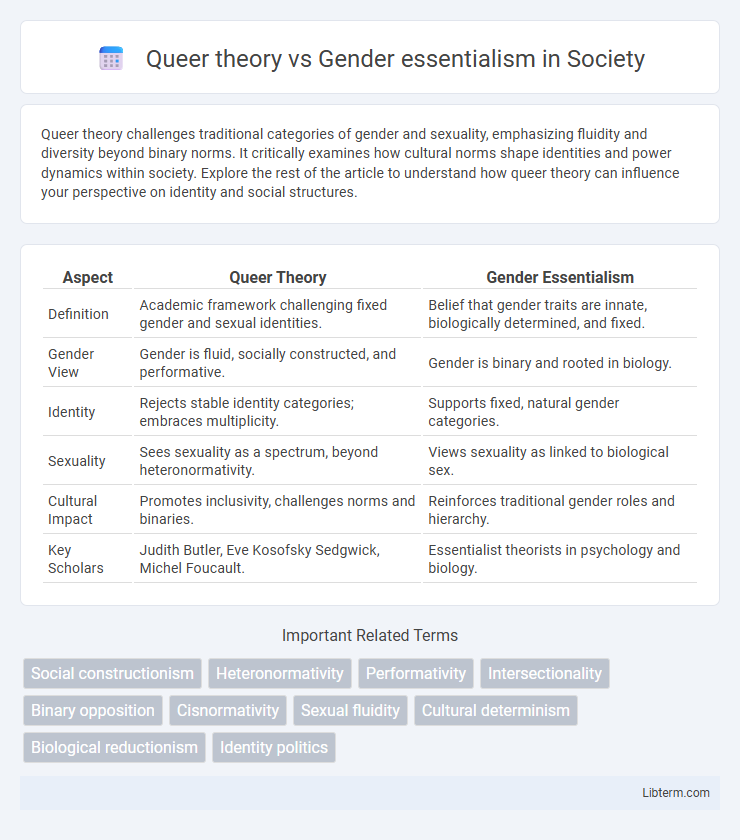Queer theory challenges traditional categories of gender and sexuality, emphasizing fluidity and diversity beyond binary norms. It critically examines how cultural norms shape identities and power dynamics within society. Explore the rest of the article to understand how queer theory can influence your perspective on identity and social structures.
Table of Comparison
| Aspect | Queer Theory | Gender Essentialism |
|---|---|---|
| Definition | Academic framework challenging fixed gender and sexual identities. | Belief that gender traits are innate, biologically determined, and fixed. |
| Gender View | Gender is fluid, socially constructed, and performative. | Gender is binary and rooted in biology. |
| Identity | Rejects stable identity categories; embraces multiplicity. | Supports fixed, natural gender categories. |
| Sexuality | Sees sexuality as a spectrum, beyond heteronormativity. | Views sexuality as linked to biological sex. |
| Cultural Impact | Promotes inclusivity, challenges norms and binaries. | Reinforces traditional gender roles and hierarchy. |
| Key Scholars | Judith Butler, Eve Kosofsky Sedgwick, Michel Foucault. | Essentialist theorists in psychology and biology. |
Understanding Queer Theory: Foundations and Principles
Queer theory challenges the fixed categories of gender and sexuality by emphasizing fluidity, diversity, and social construction, rejecting binary oppositions central to gender essentialism. It draws on feminist theory, poststructuralism, and LGBTQ+ activism to deconstruct norms that define identity strictly by biology or essential traits. Key principles include the destabilization of identity categories, critique of normative structures, and the recognition of intersectionality in experiences of gender and sexuality.
Defining Gender Essentialism: Core Concepts
Gender essentialism posits that gender differences are innate, fixed, and biologically determined, emphasizing a binary understanding of male and female identities. This perspective asserts that characteristics, behaviors, and roles attributed to genders stem from natural, inherent qualities rather than social or cultural factors. Key concepts include biological determinism, gender binary, and fixed gender roles, contrasting sharply with more fluid and socially constructed views of gender.
Historical Context: Evolution of Gender Theories
Queer theory emerged in the early 1990s as a critical response to traditional gender norms and the fixed categories promoted by gender essentialism, which has roots in 19th-century biological determinism asserting innate, unchangeable gender traits. Gender essentialism dominated early gender discourse, reinforcing binary identities based on presumed natural differences between men and women, while queer theory challenges this by emphasizing fluidity, social construction, and the diversity of gender experiences. The evolution from gender essentialism to queer theory reflects broader shifts in feminist thought, LGBTQ+ activism, and social sciences questioning normative frameworks and advocating for intersectional identities.
The Social Construction of Gender in Queer Theory
Queer theory challenges gender essentialism by emphasizing the social construction of gender as fluid, performative, and culturally contingent rather than fixed or biologically determined. It critiques essentialist views that categorize gender into binary oppositions, advocating for a recognition of diverse identities and expressions beyond normative gender roles. This approach highlights how societal norms and power structures shape gender meanings, encouraging the deconstruction of rigid gender binaries to promote inclusivity and intersectionality.
Biological Determinism in Gender Essentialism
Gender essentialism emphasizes biological determinism, asserting that innate biological factors such as chromosomes, hormones, and anatomy rigidly define gender identity and roles. Queer theory challenges this perspective by deconstructing fixed gender categories, highlighting the fluidity and social construction of gender beyond biological constraints. This theoretical clash centers on whether gender is an immutable biological fact or a dynamic spectrum shaped by cultural and individual expression.
Intersectionality in Queer Theory
Queer theory challenges traditional Gender essentialism by rejecting fixed categories of identity, emphasizing fluidity and the social construction of gender and sexuality. Intersectionality within Queer theory highlights how overlapping identities such as race, class, and disability interact with sexual and gender identities, producing unique experiences of oppression and privilege. This framework offers a comprehensive analysis of power dynamics, moving beyond singular identity dimensions to address complex systems of inequality.
Critiques of Gender Essentialism from a Queer Perspective
Critiques of gender essentialism from a queer perspective emphasize that fixed, binary notions of gender fail to capture the fluidity and diversity of individual experiences and identities. Queer theory challenges the idea that gender is innate or biologically determined, highlighting instead how gender is socially constructed and performed. This perspective destabilizes rigid categories and advocates for a more inclusive understanding that embraces nonconformity and multiplicity in gender expressions.
Real-World Implications: Society, Policy, and Identity
Queer theory challenges traditional gender norms by emphasizing fluidity and the social construction of identity, influencing policies that promote inclusivity and protect LGBTQ+ rights. Gender essentialism asserts fixed, binary traits tied to biological sex, often shaping laws and social attitudes that reinforce rigid gender roles and limit individual expression. These contrasting perspectives impact real-world issues such as anti-discrimination legislation, healthcare access, and educational curricula, directly affecting social acceptance and the lived experiences of diverse gender identities.
Queer Theory and the Fluidity of Gender
Queer theory challenges traditional notions of gender by emphasizing the fluidity and socially constructed nature of identity, rejecting fixed categories. It argues that gender is not an innate, binary attribute but a dynamic spectrum shaped by cultural, historical, and personal contexts. This perspective contrasts with gender essentialism, which asserts that gender traits are biologically determined and immutable, highlighting Queer theory's focus on diversity and the deconstruction of normative gender roles.
Future Perspectives: Bridging or Deepening the Divide?
Future perspectives on Queer theory versus Gender essentialism hinge on whether emerging interdisciplinary research and social movements will bridge gaps or deepen divides between fluid identity constructs and fixed biological determinism. Advances in neuroscience and sociocultural studies may offer integrative frameworks that reconcile gender fluidity with essentialist views, fostering inclusive policies and educational reforms. The trajectory of academic discourse and activism will significantly influence legal recognition, healthcare access, and social acceptance of diverse gender identities worldwide.
Queer theory Infographic

 libterm.com
libterm.com